Larry Weber believes the best is yet to come in plasma televisions. And few people in the world know more about plasma TVs than he does.
Many TV industry insiders would agree that Weber, 59, has left an indelible imprint on the world of consumer electronics. One of the most respected people in the field of plasma research, Weber is technically retired. But the scientist with the trademark long, white beard is not calling it a career just yet.
That's because, as he puts it, "The best invention for plasma displays hasn't been done yet." Though he retired from Panasonic in 2004, he still whiles away time in his basement working on ways to reduce power consumption, one of plasma's persistent problems.
Weber has been a consistent contributor to the technology behind modern plasma displays for four decades. He got his start in the industry as a college student in the 1960s and to date holds 15 patents on plasma displays. Weber has also had a hand in many of the most important milestones in the advance of the plasma business, such as lower power consumption, high-contrast ratio and plasma's move into the big-screen TV market. He currently volunteers as president of the Society for Information Display and has many fans in the business.
"You could really say that if it wasn't for Larry Weber, there probably wouldn't be a plasma TV business as we have it today," said Paul Liao, chief technical officer for Panasonic North America. Liao worked with Weber from 1996–when Panasonic's parent company Matsushita acquired Weber's company Plasmaco–until Weber's retirement. "Larry is a real visionary with a tremendous passion to see that vision come true."
Early plasma panels
 It's been a bumpy ride for the inventor, who has watched what was once a revolutionary technology become slowly commoditized over the last four decades. If he does figure out how to make plasma TVs suck less energy, it "will be bigger than any of them I've done so far," he said excitedly in a telephone interview from his home in upstate New York. He's not the only one looking into the problem and could probably afford to take a break, but that doesn't look likely.
It's been a bumpy ride for the inventor, who has watched what was once a revolutionary technology become slowly commoditized over the last four decades. If he does figure out how to make plasma TVs suck less energy, it "will be bigger than any of them I've done so far," he said excitedly in a telephone interview from his home in upstate New York. He's not the only one looking into the problem and could probably afford to take a break, but that doesn't look likely.
"It's part of my passion, something I've got to do," he said. "It's such a big opportunity to get to completely change everything."
As a student at the University of Illinois at Urbana-Champaign, Weber met Don Bitzer and Gene Slottow, engineers who are credited with inventing the plasma display in 1964. Simultaneously, Japanese electronics maker Fujitsu and television station NHK were also working on a slightly different version of plasma. Intrigued by Bitzer's and Slottow's work, Weber decided to study under them for his postgraduate work. Thinking back, Weber says the project didn't exactly exude signs of real-world promise.
"It was nothing very exciting," Weber said. "It looked like some professor's pet project that looked like it wasn't going to go very far."
Still, he was hooked. Though most engineers dreaming of a future in hardware chose to research semiconductors, Weber stuck with plasma. A display that could show graphics well was desperately needed at the time, not for televisions, but for companies and researchers to display high-quality graphics. Unlike plasma research today, cramming as many pixels into a superthin form factor wasn't a priority–simply finding a way to make an image remain on a screen for more than a couple of hours was the main challenge.
The power consumption challenge
Weber's tackling of power consumption today is in some ways a reprisal of past work. After completing his studies, he stayed at the University of Illinois as a professor, heading the plasma display research group. For one of his first important contributions, Weber concocted a way to reduce the power for the display's circuitry. Today, every color plasma display uses his invention, called an energy recovery sustain circuit, which knocks down power consumption by up to 150 watts.
After discovering that, the next step was to put energy recovery sustain circuit to practical use. In the U.S., plasma was being widely researched at companies like AT&T, Texas Instruments and IBM. One by one, the biggest companies were dropping out of the plasma business, and in 1987, Weber received disheartening news: the world's largest plasma plant, run by IBM in Kingston, N.Y., would be shut down in favor of manufacturing mainframe computers. Weber took the news particularly hard.
"I'd worked on it for 18 years by that point," he said. "My dream had just evaporated."
Source: Erica Ogg, Staff Writer, CNET News.com







